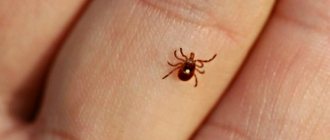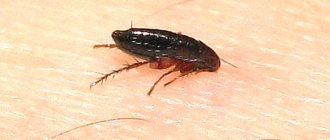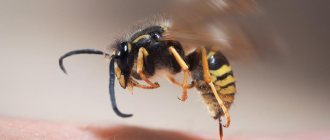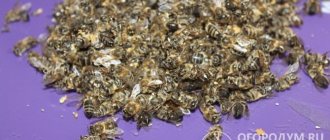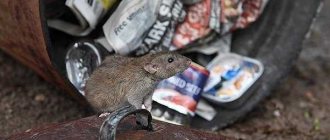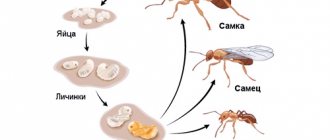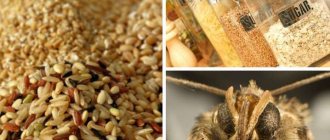Researchers have found the average lifespan of a mosquito depending on its living conditions: it ranges from 3 to 12 months. Mosquitoes are pests that become active in the summer and can greatly interfere with the lives of people and animals. However, despite their prevalence, not everyone knows how long an individual can live and under what conditions.
What to do in such a situation? To get started, we recommend reading this article. This article describes in detail methods of controlling parasites. We also recommend that you consult a specialist. Read the article >>>
Where does the life of mosquitoes begin?
The very first mosquitoes begin to appear in early May - they emerge from pupae. Then all individuals begin the mating process, after which the female begins to lay eggs. They need a moist environment to develop, so most often this is damp soil or water. If these are urban mosquitoes, then they prefer to choose the walls of sewers or basements. Each individual goes through 4 stages of its development:
- Egg;
- Larva;
- Pupa;
- Imago is an adult individual.
This transformation can last in different ways: it usually takes from 20 days to 2-3 months.
Under ideal conditions, the larva will be born within 9 hours after the female lays her eggs. Outwardly, they look like small worms and caterpillars of a brown-gray color. There are special organs on their bodies (they are called spiracles) that help them live in water and dive there. The basis of their nutrition at this time is water filtration. One such larva can pass through itself about 1 liter of water in one day, feeding on microorganisms.
mosquito larva
If all conditions are favorable, the larva usually has time to develop within a week or 2 days. During this period, their body begins to gradually increase in size, and then the formation of a pupa begins. In this case, the cocoon must also be located in water: it is an absolutely non-moving substance that does not eat anything. Processes take place inside it that precede the emergence of an adult. After a few days, the imago is born and breaks through the entire structure of the cocoon.
Larvae in water
If the cocoon was formed at the end of summer, then during the winter all processes inside freeze. The pupa helps the larva to exist for 11 months, so it will not be afraid of winter frosts. If mosquitoes breed in an area where the warmth lasts for a couple of months, they can only give birth to one generation.
Cycle of life
After the eggs are shed, birth begins some time later. The stages of mosquito development are divided into several stages:
- the egg takes on the appearance of a bubble in which air may be present. That's why they hang in the water. A week later the larva appears.
- The larva resembles the appearance of a worm. She has small brushes in her mouth that are designed to search for food and filter water. Small worms use organic debris, algae, and certain bacteria to feed. They need air for full development, so they periodically rise to the surface.
- Pupae appear after 14-21 days. They look like tadpoles in appearance. They don't eat food. After 2-4 days they develop wings and limbs. To maintain life, the pupa absorbs air.
The life cycle of mosquitoes covers all these three stages, it takes from two weeks to 40 days. Gradually, an adult individual is formed from the pupae; it develops wings, mouthparts, limbs and other important parts of the body.
How long do mosquitoes live?
When the female begins the mating season, her level of aggression increases several times. She needs blood to continue her family line. However, the number of years that adults will live will depend entirely on three factors:
- Air temperature;
- The territory where they live;
- The presence of organisms that can give them blood.
The main factors that can extend the life of a mosquito are air temperature and environmental conditions. The most optimal mode will be considered 10 degrees Celsius. The higher the air temperature, the shorter the lifespan of these creatures. Of course, we should not forget about the amount of food that mosquitoes require to survive. After a small human bite, a mosquito can live up to 119 days. At the expense of blood, a female mosquito can continue her offspring, since for this process she needs a large amount of nutrients contained in the blood. If the female lacks food, then her offspring will take over all the vital forces, and the adult insect itself will die. That is why the lifespan will depend on how many opportunities the mosquito has to eat well.
If we consider how the air temperature and the lifespan of a mosquito depend, we can notice a corresponding pattern: the lower the temperature, the longer they can live in such conditions. However, they are considered heat-loving creatures. That is why in an apartment they can often sit on the ceiling - the air temperature there is always higher, but at the same time it will be impossible to get them out of there with slippers.
Interesting facts about the life of mosquitoes
An insect can survive the winter period in a stupor, which saves its body. If we talk about the territories where they live, here they give preference to bodies of water with standing water - it is in such areas that they feel most comfortable. In addition, the most favorable places for their residence and reproduction are:
- Wetlands;
- Dense shady forests;
- Plains and lowlands.
Mosquitoes in nature
This distribution of insects is associated with the developmental characteristics of their larvae in the process of formation. Most often now you can see an ordinary mosquito, which causes a lot of trouble for ordinary people. Summer is the time for their active distribution. The number of days mosquitoes will live depends on several important environmental conditions:
- There should be accessible food sources nearby. They develop best in forests, fields and anywhere where there are plants and herbs. For females, it is necessary that animals or people live nearby, otherwise they will not be able to give birth to healthy offspring.
- Ambient temperature. The most comfortable temperature for insects to live is 10 degrees Celsius.
- Comfortable environment. The level of humidity in the area is of great importance here. That is why insects can be found in basements and utility rooms, as well as in basements.
- The presence of a large number of enemies.
Mosquito and forest moss
The lifespan is also determined by the availability of nearby available power sources. An interesting fact is that males feed on plant foods, and blood is food exclusively for female insects. During the mating season, they can attack almost all types of animals and humans. Of course, the presence of enemies also affects their lifespan: dangerous creatures for mosquitoes are birds, insectivores and humans themselves.
Mosquito: description, structure, characteristics. What does a mosquito look like?
The mosquito has a thin body (4-14 mm), long legs, and narrow, transparent wings (their span is 5-30 mm). Most are yellow, gray or brown. There are also green and black insects.
Body structure of a mosquito
The mosquito's abdomen has an elongated shape. It is divided into 10 segments. The chest part of the body is noticeably wider. At the end of each paw there are pairs of claws. There are scales on the surface of the wings. In places where their density is too high, spots can be seen.
Mosquitoes have a pair of antennae consisting of 15 parts. The oral apparatus of insects is of the piercing-sucking type. Both females and males have a proboscis. However, in females it is longer and equipped with piercing bristles.
Interesting fact : although females are larger than males, their weight barely reaches 1 gram. Getting into the web, the insect does not create vibrations - the spider will not even notice the presence of the mosquito.
The structure of the oral apparatus distinguishes insects from other blood-sucking insects. The organs are represented by the lips – upper and lower. Due to their elongated shape, they form a case, inside of which there are jaws. The jaws are small and sharp, file-shaped.
Mouthparts of various insects
What factors determine the lifespan of mosquitoes?
If we consider ordinary mosquitoes: females can live from 2 weeks to 30 days. For males, these figures are much shorter: they usually live from two days to three weeks. If we consider the modern species of these insects, then scientists claim that the lifespan of mosquitoes has decreased significantly, but this is compensated by a high level of fertility. This trend is associated with the active actions of people who are trying with all their might to eradicate this insect. If we consider in more detail the factors influencing the life of mosquitoes, it is worth highlighting the following:
- Temperature conditions in a certain area and the availability of water sources for further reproduction;
- Temperature changes, as well as the presence of frost;
- Vegetation cover that can protect the insect and hide it during the daytime;
- Activity of mosquito enemies: the presence of other insects, fish and small birds, as well as amphibians in the territory.
However, scientists have identified other factors that may also affect their life expectancy. Mosquitoes often become infected with viral infections, and small parasites can also live in them, but scientists have not yet been able to determine the exact statistics of mortality due to this. Despite everything, this species has lived on Earth for more than 400 million years, but remains widespread in various territories and can adapt to any living conditions.
Additional factors
In addition to the main factors that directly affect the life of a mosquito, there are several points that have a greater impact on the life expectancy of the insect. Now scientists have identified several significant factors that are difficult to argue with:
- Air temperature has a significant impact on lifespan. Despite the fact that the mosquito loves warmth, it becomes more tenacious in cooler weather. Heat is detrimental to this species. If the temperature exceeds 25 degrees Celsius, the period is reduced, and at lower temperatures it increases.
- The more often a mosquito feeds, the longer it lives. Males need constant flower nectar, which maintains their vitality, but females need blood supply, otherwise they will not be able to bear their offspring. Since insects cannot always find blood for food in the forest, they live much less in this area.
- Disasters in the environment - force majeure can greatly influence how long an individual will live. The list of such disasters includes hurricanes, heat, drought, sudden changes in climatic zones, rainstorms, etc.
- Gender of the insect. Scientists have already proven that males live much shorter than females. At the same time, no scientific explanation has been found for this phenomenon, but it remains a fact.
How does a mosquito bite?
Before biting the victim, the mosquito must find it. His sense of smell is responsible for this process. There are 72 types of receptors located on the insect antennae. At least about 30 of them are able to recognize various substances that are present in the sweat of humans and animals.
Mosquitoes are able to distinguish the movement of an object in space. When the insect approaches, we hear an annoying buzzing sound. This sound occurs due to very fast and frequent flapping of the wings. Mosquitoes bite more actively at night.
The female mosquito plunges her proboscis into the hole she made.
Having discovered the victim, the female sits on the surface of the skin, clinging to it with her claws. She then easily pierces the skin using her sharp jaws. The proboscis plunges into the hole. But before sucking in the blood, the mosquito injects its saliva.
It contains special substances - coagulants, which slow down blood clotting. The female immerses her proboscis quite deeply - up to the blood capillaries. Through it, it absorbs blood, from which it receives valuable substances.
The process of absorption of food by a mosquito takes no more than a minute. After this short time, the previously barely noticeable body of the insect becomes larger. The walls of the abdomen stretch and you can even see blood through them.
Photo of a mosquito under magnification
Interesting fact : mosquitoes rarely travel long distances. During their entire life cycle, they are usually found within an area of one kilometer.
Lifespan of mosquitoes after biting a person
There are cases when an individual can lay eggs without having a large amount of blood in its body. However, such a process will be disastrous for the adult individual itself - within a day after laying eggs, the female will die, and the unprotected offspring will subsequently decrease by half.
That is why the presence of nearby protein nutrition for the female is important - if such an organism is nearby, the individual will be able to replenish its energy reserves at any time, and then live its full cycle. After biting a person, the female can live for another 4 months.
Area
Mosquitoes are widespread throughout the globe and inhabit all continents except Antarctica. The widest range is the common mosquito (Culex pipiens), which is distributed everywhere where humans, its main victim, are found.
In warm and humid tropical regions they are active throughout the year, but in temperate regions they overwinter, entering diapause at one of the developmental stages (usually the adult or egg stage) during the cold season. Arctic mosquitoes remain active for only a few weeks a year, when heat causes thermokarst pools of water to form on top of the permafrost. However, during this time they manage to breed in huge quantities - swarms of mosquitoes can take up to 300 ml of blood per day from each animal in the caribou herd.
The eggs of mosquitoes living in temperate latitudes are more resistant to the negative effects of cold than the eggs of mosquitoes common in warmer climate zones. They can even withstand exposure to snow and freezing temperatures. In addition, adult individuals can survive throughout the winter in habitats suitable for their wintering (for example, warm and humid basements of residential buildings).
Distribution media
Humans have contributed to the spread of various species of mosquitoes throughout the world and their movement over long distances into regions where they are not native. First of all, these are journeys along sea routes, in which eggs, larvae and pupae of mosquitoes are transported in worn-out tires filled with water or containers with cut flowers.
However, in addition to sea transport, mosquitoes have actively mastered travel on personal vehicles, trucks, trains and even airplanes. Thus, the spread of mosquitoes is difficult to control, and even quarantine measures have proven to be ineffective and difficult to implement in practice.
How long can they live without bleeding?
And again, here everything completely depends on the sex of the insect, since the lives of males and females are completely different from each other:
- The lack of blood does not affect the lifespan of males in any way - they feed only on plant components in nature.
- The female needs to feed on blood only after fertilization and immediately before laying eggs - if after hatching the larvae she does not drink blood, she will not be able to live for more than two days.
The rest of the time, the lifespan of mosquitoes is determined solely by the temperature at which they have to survive without blood. The insect can live in the winter season in the bark of a tree or in a warm room. As a protective mechanism, diapause begins in the mosquito's body: at this moment the insect's metabolism slows down, and as soon as the warm season arrives, the individual will wake up again. Taking into account suspended animation, the female can live up to 1 year.
Meaning in human life
Globally, mosquitoes are beneficial. They pollinate plants, transport many valuable microelements, and are the main food for some organisms. The disappearance of these insects will cause significant harm to nature. However, for people they are only a source of unpleasant bites and a threat in terms of the spread of dangerous diseases.
Mosquito statue
Interesting fact : Canadians erected a monument to a mosquito in the city of Komarno. It is not only the fact that there is a monument to the insect that is surprising, but also its dimensions – the wingspan of the statue is 5 meters.
How long does a female mosquito live without blood and after a bite?
There is a myth that a mosquito dies immediately after being bitten - however, this statement is completely false. Good nutrition, which consists of obtaining nutrients from the blood, is the key to a long life for an insect. Blood helps maintain the creature's energy balance, as well as lay healthy offspring. If the female drinks enough blood, she will be able to lay a large number of eggs, from which strong and tenacious offspring will emerge.
But without blood, the situation is not so pleasant for the individual. Its lifespan is reduced several times. If fertilization has passed, but the female has not been able to bite any creatures, then she will still lay eggs. However, the resulting offspring will be weak, therefore, most likely, they will not live long either - at most, a few larvae will survive. The female will no longer survive for sure, because all her strength will be given to the offspring, and she will not have any energy reserves.
Nutrition
Only the female feeds on the blood of animals and humans. She needs protein, which is used for reproduction, maintenance of vital functions, and full activity.
Females find the source of blood quickly; they sense it by the emanating heat and the smell of carbon dioxide that a person or animal exhales.
But mosquitoes bite and drink not only human blood, they can attack wild animals in the forest. Livestock in rural areas, rodents, and even birds. An individual weighing 2.5-3 mg can drink up to 5 mg of blood at a time.
Mosquitoes also use plant sugars as food. They are extracted from plant nectar, which contains useful nutrients.
The latter are required to replenish strength and energy. Insects prefer the following plants:
- burdocks;
- blooming tansy;
- broadleaf yarrow.
Does a mosquito die when it bites a person?
Here we can definitely say that this is not true. The issue has already been discussed above that female mosquitoes need to drink blood in order to extend their lifespan, as well as to give birth to offspring - and human blood can best help with this. Laying eggs can last 2-3 days, so individuals need to constantly refresh themselves and accumulate their strength. That is why the completely opposite judgment is true: the more often an individual bites people, the stronger and healthier it and its offspring will be. A human bite does not have negative consequences for mosquitoes in the wild, but is this the case if the mosquito is in an apartment?
Here you already need to look at the air temperature and other factors that affect their life expectancy. But they definitely won’t feel worse after the bite. There is even an approximate gradation of air temperature and lifespan of these insects:
- At temperatures above +25 they live from 41 to 45 days;
- Room temperature at 20 degrees – up to 60 days;
- At 15 degrees and below, they reach a maximum period of 119 days (at a temperature of 0 degrees, the individual simply falls into torpor).
In general, a female can live for as long as 4 months after being bitten, which is considered a record for this species. Females can die if bitten by a person - this is the only option when the mosquito will die immediately. By the way, it is this factor that influences the fact that in fact these insects live much shorter - they die not from natural causes, but from attacks by predators (birds, flies, bats, frogs, etc.).
Why do mosquitoes bite some people more than others?
Bites from several mosquitoes
Surely many have seen something like this - when mosquitoes bite one person more actively than others. This is not an accident, because insects are guided by certain chemicals released later. Experts point to several factors that attract mosquitoes:
- Physical exercise. Actively moving, a person begins to sweat more. The amount of lactic acid increases, which attracts insects. Body temperature also increases.
- Blood type. Surprisingly, mosquitoes like a certain blood type, namely I. Scientists believe that carriers of this group emit a special odor that insects recognize.
- Alcohol. For unknown reasons, mosquitoes are more likely to bite people who have alcohol in their blood.
- Pregnancy. Women in late pregnancy exhale more carbon dioxide (21%). A variety of receptors allow insects to “measure” its content in the air. A similar rule applies to tall and heavy people – mosquitoes also bite them more often.
- Color of clothes. This is not a physiological factor, but dark shades of clothing attract mosquitoes more than light ones.
- Genes. Scientists have found that there is a certain connection between bites and at the genetic level. People with certain genes produce substances that repel mosquitoes. But this issue has been little studied.
Interesting fact : According to scientists, it takes about 1,200,000 mosquitoes to drink all the blood of a person.
How long do mosquitoes live in a house?
Depending on home conditions, there may be several options for the lifespan of these insects indoors. Approximately from 4 to 30 days.
Everything will depend on whether the female has time to bite a person during the process of bearing eggs. Sometimes even two weeks can cause a lot of inconvenience to a person, since annoying insects are constantly buzzing above your head and trying to bite you.
Another problem may be the eggs themselves, which the female will lay - this individual can produce about 300 eggs at one time.
Where do they disappear to?
In nature, the activity of mosquitoes is highly dependent on the ambient temperature. Insects do not tolerate temperatures below 10 degrees Celsius very well, and die at 2 degrees. Therefore, with the first frost, insects cease to exist and disturb.
As for living quarters, mosquitoes do not disappear anywhere, they simply die without food. Males come first, and then females later, even if they have drunk blood. The fact is that strategically important foods for mosquito nutrition are nectar and plant juice, and if such pleasure is not observed in the living room, the female will die in 2-3 days. The presence of indoor flowers significantly prolongs the life of a female mosquito. If she manages to drink blood and become fertilized, she may well lay her eggs somewhere in a damp place under the bathtub, in the underground or in a watered indoor plant.
Useful links How ultrasonic mosquito repellers work can be found in our article.
In general, our mosquitoes are not such dangerous insects; the only harm they cause is intrusiveness at night and severe itching from bites the next day. A mosquito bite is nothing more than a microallergic reaction of the body, which manifests itself according to all the rules of this direction:
- swelling,
- redness,
- itching
However, antibodies that are constantly present in human blood are able to suppress the pathological effects of protein antigens in mosquito saliva. But some people, especially those with reduced immune defenses against mosquito bites, may experience more serious reactions that become system-wide - shortness of breath, changes in blood pressure and even loss of consciousness, which resolve with proper treatment.
How long do mosquitoes live in an apartment?
In this case, it is worth immediately noting one important fact: in a closed room, a mosquito can live its full life cycle favorably. The air temperature is always stable here, there is access to water, etc.
After laying eggs, a small mosquito will appear within a couple of days, and a week will be enough for it to grow into an adult, which will be ready for further reproduction.
At one time, the female lays from 30 to 300 eggs, but the cycle itself will depend on the air temperature, which is constantly maintained in the room
How long can mosquitoes live
The search for an answer to this question is influenced not simply by people's curiosity. Mosquitoes make it difficult for almost everyone to live peacefully in the summer season: red blisters appear on the body - these are the sites of insect bites. This means that they managed to fly into the room. If traces have been discovered, then people begin to actively search for where the offender hid. However, if no traces of his presence are found, then there is a possibility that he died. But the chances of such an outcome are too small - perhaps he was simply too well hidden.
An apartment or house is an ideal living environment for a person, since the following factors take place here:
- High humidity;
- Comfortable air temperature.
In addition, human blood is always nearby, which allows you to maintain vitality and feed your offspring. Most often, mosquitoes can be found on the ceiling, since it is in the upper part of the apartment that warm air accumulates, which insects love so much. Such conditions are as comfortable and cozy as possible for them.
Some researchers argue that since insects cannot exist in too cold air, they do not rise above 8 meters. Some people, based on this judgment, conclude that in high-rise buildings and apartments on high floors they are completely protected from these pests. Therefore, windows can be kept open without any protective equipment even in summer. But in practice the situation is not so favorable. Even if you live on the 16th floor, you are not immune from attacks by bloodsuckers. The best way to prevent them from appearing in your home is to install mosquito nets during the summer season. The fact is that mosquitoes can fly very high on purpose to get into a person’s warm room, even on the 20th floor.
Mosquitoes on anti mosquito net
Mosquito nets, although they are a good means of protection, do not guarantee the fact that mosquitoes will not be able to enter the living space. There are several other ways they can end up in an apartment: they can fly through sewer pipes or ventilation. They can also fly into the apartment from the entrance when you come home - if a mosquito sits on the door and does not move, then a person simply will not notice it. But as soon as the door opens, the pest will immediately fly into the warm apartment. The problem is that they can live in an apartment for a long time and then leave more offspring. Typically, mosquitoes breed larvae in drain siphons, where it is always warm and humid.
Types of mosquitoes, photos and names
The blood-sucking mosquito family consists of at least 3,600 species. It is worth highlighting a few of the most common:
- ordinary (squeak);
- malarial (anopheles);
- centipede (karamora);
- chionei (winter);
- jerk;
- brindle;
- burning;
- nipper.
The squeaking mosquito is the most common. The size of most individuals is 3-7 mm. Males eat only plant matter, and females eat including blood. They are also larger. Insects are found near bodies of water, but in general they are unpretentious to the conditions.
Squeaker mosquito
The malaria mosquito or anopheles is characterized by longer hind legs and antennae. For this species, high levels of moisture are vital. The bite of Anopheles is no different from the squeak, but it is these species that transmit diseases caused by parasites.
Malaria mosquito
centipede mosquito is famous for its very large size compared to others - about 8 cm. However, it does not pose a threat to people and animals, since it feeds exclusively on plant foods. Prefers to settle near ponds, swamps, and wooded areas. Sometimes it can be found in residential premises.
Interesting: Wasp
